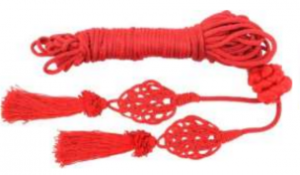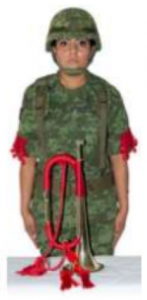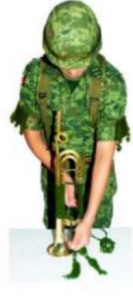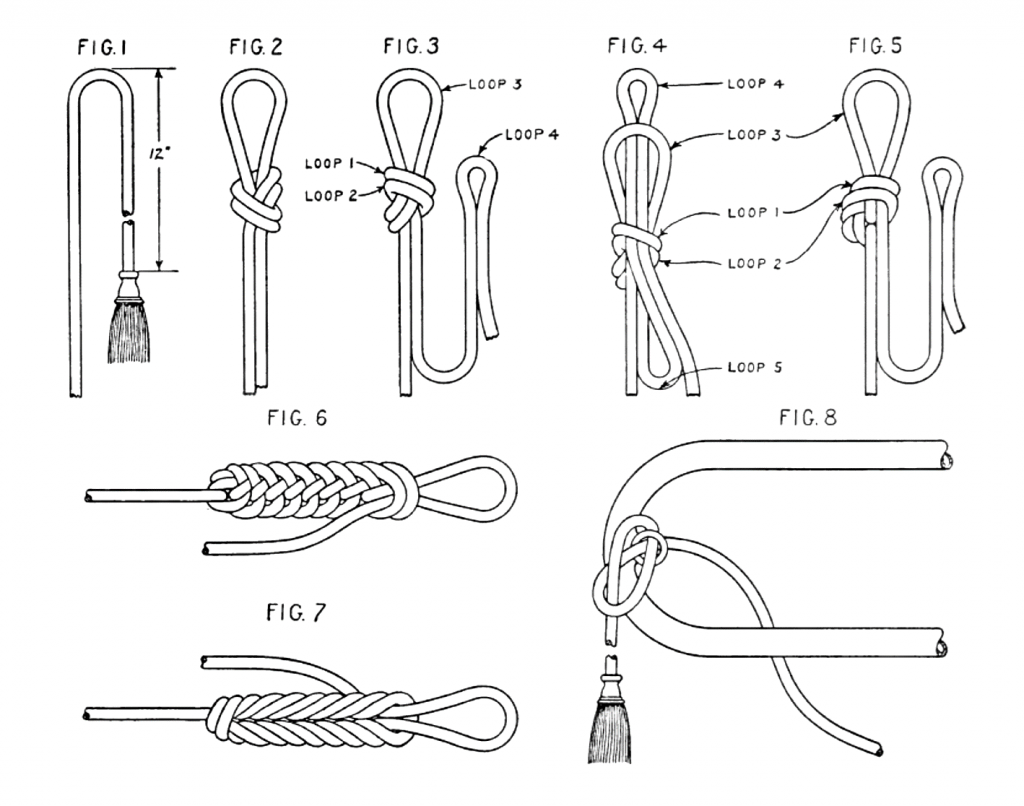Decorative cords are found on bugles in various nations. Some buglers wrap cord around the entire length of the bugle, from one bend to the other. Sometimes this is done where the bugle is held to protect the brass from the oils of the hand, and I suspect to increase grip. French bugles tend to be wrapped along the bottom of the loop using a tricolour cord (blue, white, and red). The original purpose of such cords was to keep the bugle attached to the soldier’s body. The bugle could be slung across the shoulder with the two ends attached to front and back of the bugle. The US M1894 Bugle was fielded with a leather belt for this purpose. (The belt was two pieces, held together by a buckle to allow adjusting the length). The British Royal Marines and UK Army still use bugle cords. “The Bugle Cord is used so that the Bugle can hang freely at the side of the musician when not being held. Both ends of the cord are tied to the Bugle, forming a long strap that is passed over the head and onto the shoulder of the musician.” Best information I have is the following colors:
- Household Cavalry: pale blue, yellow, and maron, with gold.
- The Rifles and Gurkhas: Black
- Light Infantry and Rifles: Green
- Royal Marines (and other royal units): red, yellow, and blue
I have not found any official sources specifying certain colors for American bugle cords. Some reenactors use bugle cords in branch colors: light blue for infantry, yellow for cavalry, red for artillery. Rank insignia, such as sergeant’s stripes, during the civil war period were colored by branch, so this system would seem sensible. Beside those three, engineers were yellow or gold, and ordnance were crimson. Green was used for uniforms of rifle or sharpshooter units.



The Mexican Army currently uses bugle cords in the color of the branch or institution (example: red for infantry), except for funeral duties where black is used. The cord is 17 meters (55 feet 9 inches) long, but is doubled over, making it 8.5 meters. Shown above is a cord used in Mexico, how it is wrapped on the Bb bugle (used in Infantry and Engineer units), the Eb trumpet (used in Cavalry and Armored units). The F Clarion (used in Artillery units) is wrapped the same as the trumpet.
Soldiers plaited their bugle cords in a variety of ways. Many knots were used to connect the cord to the bugle. Below is a series of images, from about a century ago, that show one way to set up a bugle cord. The loop of the plated section (figure 7) is placed through the ring of the bugle and tightened around the free end. The other end of the cord is attached to the other ring as shown in figure 8.

References
Ministry of Defence, Defence Equipment and Support. (2014) Technical Specification for BUGLE CORDS, BREAST CORDS, DRUM TRACERS, TRUMPET CORDS, CORDS AND TASSELS FOR COLOURS AND STANDARDS. UK/SC/6422 Issue 03. Available at: https://rmhistorical.com/files/content/UKSC%206422%20Iss%2003%20Technical%20Specification%20for%20Cords%20%26%20Tassels.pdf
Secreteria de la Defensa Nacional (2020) Manual de Ademanes y Toques Militares. DN-M-522
Lombard, Nathan C. (1910) The Trumpeters’ Manual: For the Use of Trumpeters in the Military and Naval Forces of the United States. 2nd ed., JohnWorley Co., 1910.
